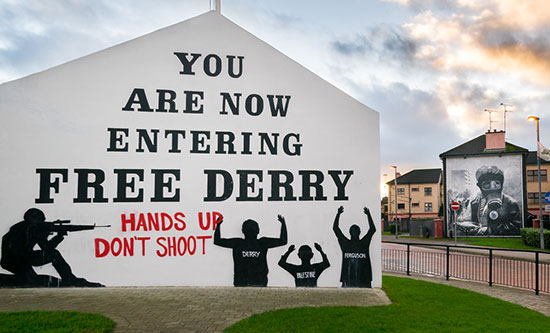
Peace or Pacification? Northern Ireland after the defeat of the IRA Liam Ó Ruairc, Zero Books, 2019. £13
Official censorship, pertaining to the North of Ireland, ended in 1994 when the London and Dublin governments lifted their broadcasting bans. War propaganda gave way to the propaganda of peace. More than that, says Liam Ó Ruairc, the process that brought us from ceasefire to Good Friday Agreement, and from there to the current power-sharing arrangements, was sustained by grand public deception. It required ‘a campaign of blatant media manipulation,’ directed by the British government, ‘to flood Northern Ireland with positive stories about the peace deal’ (p5). British state censorship was rendered obsolete by self-censorship. From the university academic to the Sinn Féin spokesman, with an agreed peace came agreed truth; real truth became the lie. Stormont press officers outnumbered journalists in Belfast newsrooms; they wrote the story.
Breaking truce with falsehood, one can discern where Irish Republicanism is in reality; how it got there; and where, if anywhere, it is going. The book returns to basics, setting out what Irish Republicanism is, and what it isn’t; why it is politically relevant and globally significant. There follows an assessment of the scale of the Republican defeat of the 1990s and its consequences. Ó Ruairc proves what took place in the Six Counties was not a process grounded in justice, capable of reconciling former adversaries, but a series of political and economic measures aimed at pacifying resistance. He shows how it secured social division and increased inequality. No less importantly, he upholds the universal and emancipatory content of Irish Republicanism.
The process and the peace
‘The peace process has to be seen as an attempt by the British state to reconstruct its authority in Northern Ireland in a context of decline and defeat of actually existing national liberation movements.’ (p34)
‘The paradox is that nationalists and republicans seem on the rise while they lost the constitutional dispute …Unionists and Loyalists feel they have lost while the Union has been copper-fastened.’ (p105)
Ó Ruairc reviews landmarks on the road to 1998. He shows to be untenable the thesis that the Republican Movement did not surrender but rather entered a pragmatic compromise with the British state. Not only was it defeated ‘but Sinn Féin has joined the enemy camp … a counter-revolutionary barrier protecting the British presence in Ireland’ (p87). Ó Ruairc reveals the gravity of this defeat, its consequences for the North’s politics and the lives of its people. He shows that those who suffered most in war, benefit least in peace. For many in former bastions of Republican resistance, ‘peace dividends’ are a long time coming. Concerning the Loyalist working class, he demonstrates the erosion of their former privileges and its political effect. Then he turns to the apparent winners.
A new Catholic middle class
Ó Ruairc argues that nationalist communal interests have been greatly advanced, benefiting from positive discrimination and public sector expansion – what he calls ‘counter-insurgency Keynesianism’ – producing a new Catholic middle class (p103). Once an insignificant minority of lawyers, priests and pub owners, teachers and doctors, serving their community, the new Catholic middle class is significant – socially and politically. It is established in accountancy, banking, engineering and architecture, but ‘essentially concentrated in the public sector and … gradually rising to its top’ (p103). Sinn Féin is their party now. In 2001 just two of the 20 most affluent areas in the North had nationalist majorities, by 2011 six of them did (pp103-4). Left-wing axioms of the 1970s and ‘80s that the sectarian statelet was ‘irreformable’, incapable of civil equality, were therefore wrong – ‘or at least premature’ (p102).
The minor politics of identity
Politically, behind the superficial radicalism of painted gable walls, the landscape is changed utterly: self-determination, republicanism, socialism – are redefined to fit the logic of the peace. ‘From irreconcilable political projects,’ republicanism and unionism are ‘transformed into different “traditions”’ (p109). History is reworked, causes of conflict reexplained thus: Irish cultural identity was not respected; British cultural identity was perceived to be under threat. The solution? ‘Parity of esteem’ and ‘respect to all identities and cultures’ (p109). The Left confines itself to minor politics, Sinn Féin to identity politics: not contesting actual sovereignty but squabbling with Unionism over the symbolism of sovereignty – whose flag should fly where and when, what official status befits the Irish language. ‘Northern Ireland has gone from the politics of imperialism versus anti-imperialism to the narcissism of small differences’ (p111).
Victim culture
Imperialism is airbrushed or confined to ‘history’. All that remains to account for a fractious, abnormal present is the ‘legacy’: the outer ripples of an uncomfortable past, embodied in a backward facing, traumatised population. A ‘victim industry’ spawned ‘almost 50 dedicated victim and survivor groups’ by 2014 (p113). With the rise of identity politics, victim culture is indicative ‘not only of the crisis of republicanism and unionism,’ but of a ‘general weakened sense of agency’ (p114). It is symptomatic of the ‘collapse of historical forces [and] diminished political expectations’ (p120). So long as the British state is accepted as arbiter in dealing with ‘the past’, this carnival of helplessness paves a new way for Britain ‘to reassert its authority in the Six Counties’.
As Ó Ruiarc points out, Brexit changes none of this fundamentally – other than to make it all worse. Irish unity is not on the cards, let alone Irish liberty. Political accident won’t free Ireland, but Ó Ruairc’s analysis is a point of departure for those who might.
Patrick Casey
FIGHT RACISM! FIGHT IMPERIALISM! 274 February/March 2020




